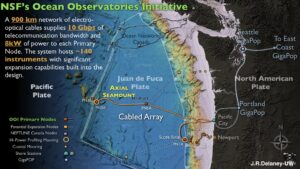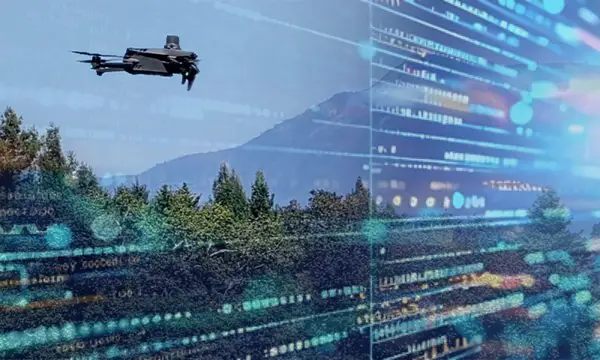- About
- Network
- Community
- Initiatives
- News
- Events
- Blog
- Publications

CENIC Recognizes John Delaney and Interactive Oceans for Revolutionizing Ocean Research by Deploying Fiber Optics for Undersea Observation
Categories Cultural & Scientific RENS & NRENS
Tags award conference innovations in networking awards national science foundation nsf oceanography pacific wave pnwgp research
CENIC announces the recipient of 2019 Innovations in Networking Award for Research Applications
La Mirada, CA & Berkeley, CA — March 19, 2019 — For transforming ocean research with fiber optic cables, cameras, and sensors that relay subsea images and data to scientists around the world in real time, University of Washington Professor John Delaney is being recognized with CENIC’s 2019 Innovations in Networking Award for Research Applications.
Delaney’s revolutionary vision and leadership helped spark Interactive Oceans and the Ocean Observatories Initiative (OOI), a National Science Foundation-funded infrastructure composed of science-driven platforms and sensor systems that measure physical, chemical, geological, and biological properties and processes from the seafloor, within the overlying water column, and into the air-sea interface. Figure 1 captures a small number of the processes in this complex environment. NSF’s OOI, writ large, has now deployed more than 750 ocean sensors across the Northern and Southern Hemispheres in the Pacific and Atlantic Oceans, but the major investment was in the OOI Regional Cabled Array in the Northeast Pacific Ocean.
At present, off the Pacific Northwest coastline of North America, there are two submarine sensor networked installations, one Canadian and one supported by NSF. These systems were conceived of together more than 15 years ago, and now operate full-time serving scientific and educational groups across the world. Figure 2 shows the relationship of these two systems compared to the Juan de Fuca Tectonic Plate. The zone nearest the continent where the JdF Plate plunges beneath the North American Plate is a potential source of devastating magnitude-9.0 earthquakes and it “bleeds” methane gas continually into the overlying ocean and atmosphere. The boundary between the JdF Plate and the Pacific Plate is a 500-kilometer spreading center — where the seafloor is pulling apart at the speed your fingernails grow (about 6 centimeters per year) — and molten rock episodically wells up into the opening in the form of volcanic eruptions every 5 to 20 years. The Cabled Array sensors track these changes continuously along with the exotic biological communities that live off the effluent from each of these plate boundaries.
“John Delaney is one of the pioneers in the use of fiber optics to build undersea observatories,” said Larry Smarr, professor of computer science and engineering at the University of California San Diego, principal investigator of the Pacific Research Platform, and director of the California Institute for Telecommunications and Information Technology. “The technologies that Delaney and his team have prototyped in the Northwest could someday be all along the coast of California.”

Wiring oceans to the Internet complements ship-based expeditions and enables scientists, educators, and the public to access real-time ocean data from anywhere. Not only are scientists able to observe and analyze previously inaccessible phenomena, but they also can remotely conduct marine experiments from anywhere in the world. As a result, researchers across California and around the globe are addressing critical science-driven questions that will lead to a better understanding of the oceans, enhancing our capabilities to address critical issues such as climate change, ecosystem variability, ocean acidification, and carbon cycling.
Pacific Wave, a joint project of CENIC and Pacific Northwest Gigapop (PNWGP) that is designed to serve research and education networks throughout the Pacific Rim and the world, provides worldwide access to the Ocean Observatories Initiative with gigabit-per-second capabilities both for high-definition video and real-time operation of undersea robots.
Smarr and Delaney have collaborated for 15 years on ways to combine computer science and oceanography. The two realized a long-time dream in November 2017 as they watched live, high-definition video transmitted from a robotic camera and observatory one mile below the ocean’s surface. “Seeing live video of the amazing complexity of sea life in one of the undersea vents makes you realize that we could have observatories discovering the dynamic complexity of nature all over the planet,” Smarr said.
California is home to a global testbed where researchers develop prototypes of marine sensors before deploying them in OOI. Built as part of Delaney’s North East Pacific Time-series Undersea Networked Experiments (Project NEPTUNE), the Monterey Accelerated Research System (MARS) is the first deep-sea cabled observatory constructed offshore of the continental United States. The small-scale, deep-water observatory connects to shore through a 30-mile fiber optic cable. Examples of experiments on MARS include testing various sensors that examine animals that thrive in the deep sea where sunlight does not penetrate; hydrophones for acoustic monitoring of the marine soundscape; and geodetic and seismic sensors to measure motion and pressure on the seafloor. MARS is a project of the Monterey Bay Aquarium Research Institute, a CENIC network member.
Expanding OOI off the coast of California could provide an early detection warning system for earthquakes and tsunamis. Wired to the Internet, observatories could provide real-time, high-bandwidth connectivity to seismometers and pressure gauges, a capability not offered by current detection systems. Axial Seamount, for example, is an active volcano and site of intense seismic and hydrothermal activity on the Juan de Fuca Ridge off the coast of Oregon. The most advanced underwater volcanic observatory in the world, the site’s array streams live data to shore for anyone to watch. The volcano’s potential to teach us about seismic activity and submarine eruptions will be a topic of Delaney’s keynote speech at CENIC’s annual conference this March.
Using poetry to articulate the mystery and beauty of ocean science, Delaney enthralls audiences with his passionate support for ocean discovery. “John is a very rare blend of science, engineering, and the humanities,” Smarr said. “A visionary and poet, he is a model of the kind of advocates we need to convert cutting-edge research to public understanding and excitement.” (View Delaney’s Ted Talk: Wiring an Interactive Ocean.)
John Delaney’s zeal for the world’s oceans — the ultimate life support of the planet — has sparked an explosion of rich data. As technological advances continue, developments in sensors, computational speed, communication bandwidth, and many other factors will continue to open new possibilities for scientific inquiry and discovery.
“John’s vision and tenacity have been transformative, and his inclusiveness, embracing informal as well as formal education, the arts and humanities as well as sciences, ensures that everyone will have an opportunity to experience and begin to understand the oceans, which matter to everyone, because they are what John Delaney has called 'the ultimate life support system of the entire planet',” said Louis Fox, CENIC president and CEO.
The CENIC Innovations in Networking Awards are presented each year at CENIC’s annual conference to highlight exemplary people, projects, and organizations that leverage high-bandwidth networking. The CENIC conference will be held March 18 – 20, 2019, in San Diego, California. Learn more and register to attend.
Related blog posts
CENIC Members Enable Data-Driven Agriculture: Optimizing Harvests in a Changing Environment
The use of technology in agriculture to increase yield and decrease resources is the focus of an innovative project fueled by CENIC and its collaborative partners: a novel model of precision agriculture in the vineyards.
The Venue is the World: CENIC Helps SFJAZZ Share Music with Everyone
Learn how Mount Allen shares musical experiences with the public through his role at San Francisco Jazz (SFJAZZ), which uses CENIC infrastructure to livestream performances to classrooms and libraries across the state.


